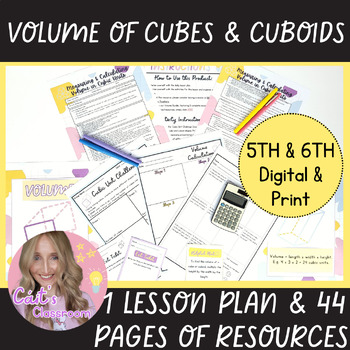Cube/Cuboid Volume Math Lesson Plan│Worksheets,Hands-on Activities│5th/6th Grade
- Zip
Also included in
- Looking for an engaging math unit on measuring the volume of 3D shapes that your fifth/sixth graders will love? Want step-by-step lesson plans, printable/digital games and activities and hands-on, project based learning and rubrics? Then this resource is for YOU!This unit is aligned with both CCSSMPrice $19.60Original Price $27.40Save $7.80
Description
Searching for an engaging lesson plan to teach fifth/sixth grade about volume using the metric system? Want it to include worksheets, digital and hands-on activities for constructing, measuring and calculating volume in cubic units? Then this resource is for YOU!
Take the stress out of creating complete lessons and resources! This lesson includes a group construction challenge, a main activity with virtual/physical opportunities for measuring and calculating volume and individual practice worksheets to consolidate key concepts.
This resource is also aligned with both CCSSM and the Irish Primary Mathematics Curriculum (2023) for seamless integration into planning documents.
Say goodbye to weekends planning on your laptop and hello to an engaged classroom – grab your copy TODAY!
Benefits
- Reduces planning demands on teachers, saving valuable time and effort while being well-designed and aligned with curriculum standards.
- Offers a complete, print-and-go resource with step-by-step instructions, ideal for newly qualified teachers who want support teaching math to the senior grades.
- Enhances conceptual understanding and procedural fluency in measuring and calculating volume in cubic units.
- Offers digital learning opportunities, fostering engagement and deeper comprehension of volume concepts in the digital age.
In Depth Description
This 50-minute lesson plan includes:
- 1 Cubic Unit Challenge group worksheet (colour and black & white)
- 15 page presentation on calculating volume in cubic units
- 8 page interactive PowerPoint game for constructing and calculating volume of cubes and cuboids
- 2 posters
- 1 group worksheet to record volume measurements for hands-on main activity (colour and black & white)
1 individual worksheet and answer key on calculating volume using the length x width x height formula - 2 pages of exit tickets (colour and black & white)
- 1 page of helpful hints for differentiation
- 3 learning objectives.
- Differentiation strategies for both struggling and advanced students.
- Formative and summative assessment ideas.
- Key vocabulary and definitions.
- Explicit links to the new Irish Primary Mathematics Curriculum (2023), focusing on the element of understanding and connecting and the competencies of being mathematical, being a digital learner and being an effective communicator.
- Explicit links with CCSSM.
5th Grade:
- CCSS.5.MD.C.3 - Understand volume as an attribute of solid figures and find volumes of right rectangular prisms by counting unit cubes and by multiplying length x width x height.
- CCSS.5.MD.C.3a - A substandard of 5.MD.C.3 focusing on finding the volume of right rectangular prisms with whole-number edge lengths in the context of solving real-world and mathematical problems.
- CCSS.5.MD.C.3b - A substandard of 5.MD.C.3 focusing on illustrating and explaining the calculation of the volume of a right rectangular prism using a model.
- CCSS.5.MD.C.4 - Measure volumes by counting unit cubes, using cubic cm, cubic in, cubic ft, and improvised units.
- CCSS.5.MD.C.5a - A substandard of 5.MD.C.5 focusing on interpreting volume as additive and finding the volume of a combination of two solid figures.
- CCSS.5.MD.C.5b - A substandard of 5.MD.C.5 focusing on applying the formulas V = l × w × h and V = b × h for rectangular prisms to find volumes of right rectangular prisms with whole-number edge lengths in the context of solving real-world and mathematical problems.
Mathematical Practice Standards:
- CCSS.MP.5 - Use appropriate tools strategically
- CSS.MP.6: Attend to precision
Don't let this opportunity slip away! Elevate your teaching experience and engage your students - secure your complete lesson plan and resources TODAY!
Click here to join the Cáit's Classroom mailing list for valuable tips, tricks, and special offers designed to support newly qualified teachers in effectively teaching maths to 3rd-6th class students.
Related Products
⭐ Cube/Cuboid Volume Lesson Plan│Worksheets, Games, Problem Solving│5th/6th Grade
⭐ Volume of Cylinders Lesson Plan │Project Brief & Assessment Rubric│5th/6th Grade
⭐ Additive Volume Lesson Plan │Worksheets, Games, Guided Practice│5th/6th Grade
⭐ Cone/Pyramid Volume Lesson Plan │Worksheets, Game, Guided Practice│5th/6th Grade






